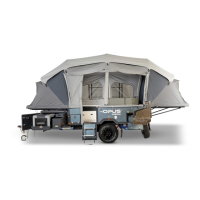18
1T
1A
3T
2T
4T
8T
7T
6T
5T
9T
9A
8A
7A
6A
5A
4A
3A
2A
ABOUT YOUR AIR TENT
TROUBLESHOOTING AIR TENT ISSUES
Inaon issues
• Make sure all of ve quick release valves are properly closed.
• Make sure there are no extreme folds or kinks in the air beams (parcularly the main air beam where the AIR compressor
hose connects to) that could prevent air being transferred to the other air beams. The compressor will be able to
overcome most folds but in some cases you may need to make a minor adjustment to the tent to allow air through more
extreme folds that could be trapping air. If this happens, gently push on the middle air pole from the outside to help it
straighten and allow the pole to inate.
• Make sure all of the isolaon valves are in the OPEN posion otherwise AIR cannot pass between beams.
• Make sure your AIR Compressor hose is securely in the AIR tent inlet valve
• Should you experience issues with your compressor, you can use the included manual pump to inate your tent. This will
take around 5 minutes.
Deaon Issues
• We recommend opening each quick release valve and re-closing it in case you have cross-threaded the valve.
• Ensure you are removing the AIR compressor hose and capping the valve once you are inated.
• If you suspect an AIR leak, use the isolaon valves to close o each air beam so that you can idenfy which leak the beam
is on. Take care not to over-ghten the isolaon valves as this can damage the valve and in itself cause a leak. Remember
to open up the valve again when you need to re-inate your tent.
Should you idenfy a leak in your air beam or valve, please use the following map and contact OPUS HQ for a replacement
beam. For eld repairs, you can use the patch kit included with your OP4. We also recommend keeping the isolaon valves
closed unl the air beam is replaced to help prevent tent collapse. For instrucons on replacing the beam, please see the AIR
beam replacement secon of this user manual under Care & Maintenance.
AIR TENT DESIGN
Your OP4 AIR tent is made of 9 connected AIR beams in the main tent (and 9 beams in the annex if you choose that addion).
The tent is inated by the compressor that is mounted in the cabinet to the right of the door. The hose from the AIR compressor
is threaded up through the cabinetry to the main AIR tent inlet valve. The compressor is acvated by the buon on the
control panel, which also has a breaker switch should this be required. The air compressor is preset to the opmum pressure
of 6.5psi and will automacally shut o when the pressure in the AIR tent reaches this pressure. Occasionally you may wish
to adjust the psi to account for variaons in outside air pressure (caused by altude, temperature and extreme wind). Our
recommendaon is to rst check the suitability of the air poles at the preset pressure. If you then decide you require more or
less pressure in the tubes the psi may be adjusted using the dial located on top of your compressor. Turn the dial to increase
or decrease the pressure as desired, however you must not increase the pressure over 9psi and we recommend returning the
pump back to 6.5 psi for normal camping.
Once your AIR tent is fully inated and the compressor shuts o, please remove the hose from the valve and cap the valve.
This will stop any air leaking out around the compressor hose. Failure to remove the hose and cap the valve may result in
tent deaon.
Each Air Beam is connected to the beams next to it by an AIR transfer hose which has an isolaon valve on each end where
it connects to the AIR beam. Each AIR transfer hose has a spring inside it to protect it from kinks and bends that could
damage the hose or prevent air passing between the beams. We recommend regular inspecon of the AIR transfer hoses
and isolaon valves to ensure they are in good condion. You can nd the AIR Transfer hoses by zipping open the semi-circle
zippers in the roof of your tent. Should you need to close o the valve, the back secon is turnable. There are markings on the
valve to show which direcon to turn for open and close. IMPORTANT! If you close o a valve, please remember to re-open
it before trying to re-inate your tent to ensure air can reach each AIR beam.
The AIR Beams are housed inside
two protecve layers; an inner thick
protecve layer and an outer layer
built into the main tent. You should
aim to keep the AIR beams enclosed
inside the layers unless you suspect
an issue with the air beam. Should you
need to access the AIR beam, ensure
that no part of the AIR beam is caught
in the zip when you close it back up.
19

